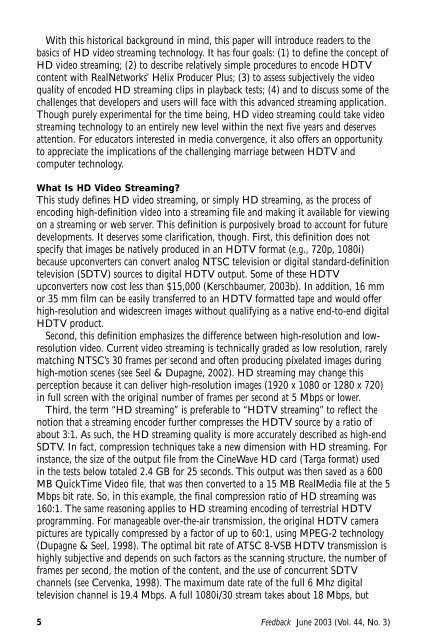JUNEFeedback
Issue 3 - Broadcast Education Association
Issue 3 - Broadcast Education Association
You also want an ePaper? Increase the reach of your titles
YUMPU automatically turns print PDFs into web optimized ePapers that Google loves.
With this historical background in mind, this paper will introduce readers to thebasics of HD video streaming technology. It has four goals: (1) to define the concept ofHD video streaming; (2) to describe relatively simple procedures to encode HDTVcontent with RealNetworks’ Helix Producer Plus; (3) to assess subjectively the videoquality of encoded HD streaming clips in playback tests; (4) and to discuss some of thechallenges that developers and users will face with this advanced streaming application.Though purely experimental for the time being, HD video streaming could take videostreaming technology to an entirely new level within the next five years and deservesattention. For educators interested in media convergence, it also offers an opportunityto appreciate the implications of the challenging marriage between HDTV andcomputer technology.What Is HD Video Streaming?This study defines HD video streaming, or simply HD streaming, as the process ofencoding high-definition video into a streaming file and making it available for viewingon a streaming or web server. This definition is purposively broad to account for futuredevelopments. It deserves some clarification, though. First, this definition does notspecify that images be natively produced in an HDTV format (e.g., 720p, 1080i)because upconverters can convert analog NTSC television or digital standard-definitiontelevision (SDTV) sources to digital HDTV output. Some of these HDTVupconverters now cost less than $15,000 (Kerschbaumer, 2003b). In addition, 16 mmor 35 mm film can be easily transferred to an HDTV formatted tape and would offerhigh-resolution and widescreen images without qualifying as a native end-to-end digitalHDTV product.Second, this definition emphasizes the difference between high-resolution and lowresolutionvideo. Current video streaming is technically graded as low resolution, rarelymatching NTSC’s 30 frames per second and often producing pixelated images duringhigh-motion scenes (see Seel & Dupagne, 2002). HD streaming may change thisperception because it can deliver high-resolution images (1920 x 1080 or 1280 x 720)in full screen with the original number of frames per second at 5 Mbps or lower.Third, the term “HD streaming” is preferable to “HDTV streaming” to reflect thenotion that a streaming encoder further compresses the HDTV source by a ratio ofabout 3:1. As such, the HD streaming quality is more accurately described as high-endSDTV. In fact, compression techniques take a new dimension with HD streaming. Forinstance, the size of the output file from the CineWave HD card (Targa format) usedin the tests below totaled 2.4 GB for 25 seconds. This output was then saved as a 600MB QuickTime Video file, that was then converted to a 15 MB RealMedia file at the 5Mbps bit rate. So, in this example, the final compression ratio of HD streaming was160:1. The same reasoning applies to HD streaming encoding of terrestrial HDTVprogramming. For manageable over-the-air transmission, the original HDTV camerapictures are typically compressed by a factor of up to 60:1, using MPEG-2 technology(Dupagne & Seel, 1998). The optimal bit rate of ATSC 8-VSB HDTV transmission ishighly subjective and depends on such factors as the scanning structure, the number offrames per second, the motion of the content, and the use of concurrent SDTVchannels (see Cervenka, 1998). The maximum date rate of the full 6 Mhz digitaltelevision channel is 19.4 Mbps. A full 1080i/30 stream takes about 18 Mbps, but5Feedback June 2003 (Vol. 44, No. 3)
















